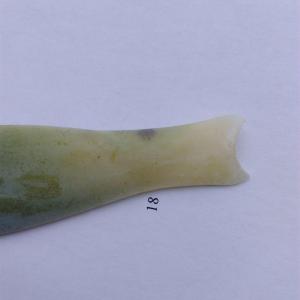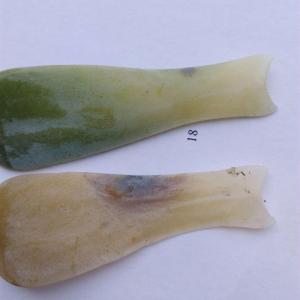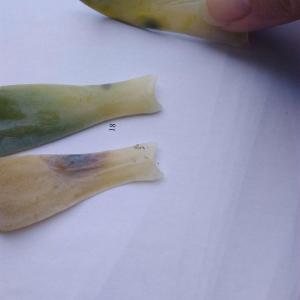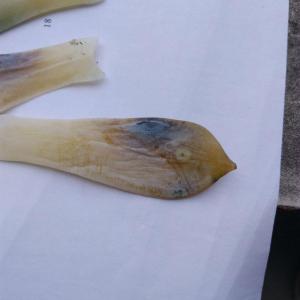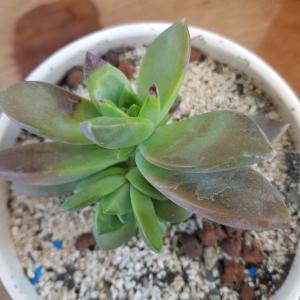文章
Dummer. ゛☀
2017年07月31日

Family - Brassicaceae
Stems - To 1m tall, herbaceous, stellate and simple pubescent, from thick taproot, branching above at inflorescence.

Leaves - Alternate, to 14cm long, 6-7cm broad, pinnate, dense stellate pubescent, reduced upward, sessile. Leaflets divided, those divisions again divided or lobed. Ultimate leaf divisions entire.
Inflorescence - Terminal racemes, compact in flower, much elongating in fruit to +30cm long.

Flowers - Petals 4, yellow, 3-4mm long, 1mm broad, spatulate, recurving slightly at apex. Stamens 6, exserted. Filaments to 4mm long. Ovary terete, 2-3mm long. Sepals 4, yellow-green, glabrous, 3mm long, -1mm broad, linear.

Fruit - Silique to 2.5cm long, 1mm in diameter, many seeded. Pedicel to 1.5cm long, filiform.
Flowering - May - July.
Habitat - Waste ground, disturbed sites, roadsides, railroads.
Origin - Native to Europe.
Other info. - D. sophia is becoming common in this state and others. I first found it in Florida. The plant is easy to ID in the field because of the much divided leaves, densely pubescent stems, and ascending long fruits. D. pinnata, a native species, looks similar but has shorter fruits, glandular pubescent stems, and leaves which are slightly less divided.
Stems - To 1m tall, herbaceous, stellate and simple pubescent, from thick taproot, branching above at inflorescence.

Leaves - Alternate, to 14cm long, 6-7cm broad, pinnate, dense stellate pubescent, reduced upward, sessile. Leaflets divided, those divisions again divided or lobed. Ultimate leaf divisions entire.
Inflorescence - Terminal racemes, compact in flower, much elongating in fruit to +30cm long.

Flowers - Petals 4, yellow, 3-4mm long, 1mm broad, spatulate, recurving slightly at apex. Stamens 6, exserted. Filaments to 4mm long. Ovary terete, 2-3mm long. Sepals 4, yellow-green, glabrous, 3mm long, -1mm broad, linear.

Fruit - Silique to 2.5cm long, 1mm in diameter, many seeded. Pedicel to 1.5cm long, filiform.
Flowering - May - July.
Habitat - Waste ground, disturbed sites, roadsides, railroads.
Origin - Native to Europe.
Other info. - D. sophia is becoming common in this state and others. I first found it in Florida. The plant is easy to ID in the field because of the much divided leaves, densely pubescent stems, and ascending long fruits. D. pinnata, a native species, looks similar but has shorter fruits, glandular pubescent stems, and leaves which are slightly less divided.
0
0
文章
Dummer. ゛☀
2017年07月31日

Family - Brassicaceae
Stems - To +70cm tall, herbaceous, erect, typically multiple from stout taproot, branching above, dense glandular pubescent.

Leaves - Alternate, sessile, to +15cm long, 6-7cm broad, reduced upward, pinnate to deeply pinnatifid, pubescence simple, forked, or branching, also glandular. Leaflets typically pinnatifid. Leaf rachis channeled above.
Inflorescence - Terminal raceme, very compact in flower, much elongating in fruit, to + 25cm long (tall). Flowers on short pedicels to 4mm long, typically glabrous. Pedicels elongating in fruit.

Flowers - Petals 4, yellow, -2mm long, 1mm broad, glabrous, spreading to recurving slightly at apex, obtuse at apex. Stamens 6. Filaments to 1.5mm long, yellow, glabrous. Anthers yellow, .2mm long. Ovary terete, subcylindric, 1mm long. Siliques to +/-1cm long, 2mm in diameter, subterete to 4-angled, many seeded. Seeds brown, 1mm in diameter. Fruiting pedicel to 1.5cm long.

Flowering - March - June.
Habitat - Waste ground, disturbed sites, open woods, prairies, glades, roadsides, railroads.
Origin - Native to U.S.
Other info. - This species is common in Missouri and can be found throughout the state. Another species, D. sophia (L.) Webb, which is introduced from Europe, is becoming common. The two can be distinguished by fruit size and leaf character.
I didn't get pics of the flowers of D. pinnata, but they are very close to those of D. sophia, so check out that page to see the flowers.
Stems - To +70cm tall, herbaceous, erect, typically multiple from stout taproot, branching above, dense glandular pubescent.

Leaves - Alternate, sessile, to +15cm long, 6-7cm broad, reduced upward, pinnate to deeply pinnatifid, pubescence simple, forked, or branching, also glandular. Leaflets typically pinnatifid. Leaf rachis channeled above.
Inflorescence - Terminal raceme, very compact in flower, much elongating in fruit, to + 25cm long (tall). Flowers on short pedicels to 4mm long, typically glabrous. Pedicels elongating in fruit.

Flowers - Petals 4, yellow, -2mm long, 1mm broad, glabrous, spreading to recurving slightly at apex, obtuse at apex. Stamens 6. Filaments to 1.5mm long, yellow, glabrous. Anthers yellow, .2mm long. Ovary terete, subcylindric, 1mm long. Siliques to +/-1cm long, 2mm in diameter, subterete to 4-angled, many seeded. Seeds brown, 1mm in diameter. Fruiting pedicel to 1.5cm long.

Flowering - March - June.
Habitat - Waste ground, disturbed sites, open woods, prairies, glades, roadsides, railroads.
Origin - Native to U.S.
Other info. - This species is common in Missouri and can be found throughout the state. Another species, D. sophia (L.) Webb, which is introduced from Europe, is becoming common. The two can be distinguished by fruit size and leaf character.
I didn't get pics of the flowers of D. pinnata, but they are very close to those of D. sophia, so check out that page to see the flowers.
0
0
文章
Miss Chen
2017年07月30日


¿Qué luz necesitan? Lugar con mucha luz, aunque el sol directo todo el día podría provocar quemaduras en especies delicadas. Lo mejor es sol una parte del día, al menos unas 5 ó 6 horas de sol, de mañana o de tarde.
Cactus grandes toleran más sol que los pequeños.
¿Qué temperatura necesitan?
Dependerá de las especies, pero en general, si la temperatura baja de +5ºC, muchas Suculentas, sobre todo las que provienen de zonas tropicales, pueden morir.
Los cactus en su hábitat natural, por las noches, las temperaturas alcanzan algunos grados bajo cero.
Cuando el termómetro baje de 10º-15º C es muy importante conservar el substrato de las macetas totalmente seco. Por tanto, si tienes cactus en macetas en el jardín, es aconsejable disponer de un sitio que no se mojen con la lluvia, una zona cubierta con algún material traslúcido como un techo de plástico. Además el techo resguarda del frío, aunque en climas con heladas fuertes no es suficiente protección y hay que meter dentro de casa o en un invernadero.
¿En qué consiste la invernada?
Para garantizar la floración de los cactus, conviene dejar la planta en estado de reposo durante el invierno, reduciendo al mínimo los aportes de agua y nada de abono.
Hazlas invernar dentro de casa en un sitio fresco y luminoso, por ejemplo el dormitorio. Por ejemplo, la pequeña Lobivia silvestrii (o Chamaecereus silvestrii) sólo florecerá si ha soportado un golpe de frío durante el invierno.
Una vez terminado el reposo, evita sacar las plantas de golpe al sol tras pasar el invierno a cubierto. Si ha estado en penumbra corre el riesgo de quemaduras irreversibles. Finalmente, no debes retomar la fertilización hasta avanzada la primavera.
¿Cómo debe ser el substrato para cactus y Suculentas?
Venden unos preparados que se les suele llamar "Sustrato para cactus". Sólo hay que tener en cuenta que vienen poco abonados por lo que se les debe añadir fertilizantes minerales.
La otra opción es hacerte tu propia mezcla. Lo fundamental es que el substrato nunca quede encharcado. Se recomienda que el 50% de la mezcla sea arena de río lavada y gruesa, el otro 50% entre turba negra y perlita. Se debe añadir a este sustrato abono, por ejemplo, uno de lenta liberación.
La mencionada arena de río lavada y gruesa no es fácil de encontrar en el comercio, pero es la ideal. La arena de la construcción no es recomendable por su contenido alto en caliza, sales y poca aireación al tener granos gordos y finos.
Para cactáceas epifitas, las que brotan en los árboles de las selvas tropicales, usa un sustrato convencional para plantas de interior.
Finalmente, ciertas plantas crasas (Ágaves, Euforbias, Compuestas y Aizoáceas) son bastante indiferentes en cuanto a la composición de la mezcla, con la condición de que drene bien.
Macetas
Para el exterior, donde no podemos controlar el riego en el invierno, conviene que las macetas sean de barro o terracota u otro material transpirable. De esta manera, facilitamos la pérdida más o menos rápida de la humedad del substrato.
No proporciones a la planta una maceta excesivamente grande, ya que ésta acumulará más humedad.
Conviene sustituir tanto en la parte superior como en la inferior de la maceta, dos centímetros de substrato por algún tipo de árido de grano grueso, de unos 10 mm. como mínimo, para evitar la posible podredumbre de la planta. Con un taladro haz varios agujeros más de drenaje a la maceta para facilitar la salida del agua.
Para casa o en invernadero son buenas las macetas de plástico.
Se pueden adornar las macetas con rocas volcánicas, cantos rodados o grava en la superficie.

0
0
文章
Dummer. ゛☀
2017年07月29日

Family - Hippocastanaceae
Stems - Woody to 9m tall, with a single trunk or multiple trunks.
Leaves - Opposite, palmately compound, petiolate. Leaflets typically 5, but sometimes 6 or 7, 3-8cm wide, 15cm long, serrate, pubescent below, glabrous above, acuminate. Petiolules to 1cm long.
Inflorescence - Terminal panicle to 20cm long on new season growth. Axis of inflorescence densely pubescent with multicellular hairs. Pedicels pubescent, to 8mm long in flower.
Flowers - Petals 4, pale yellow to creamy whitish, clawed. Claws of upper petals to 3.5mm long, with dense tuft of villous pubescence at apex. Limb of upper petals +1.5cm long, 4mm broad at apex, with reddish spot near base of limb, pubescent. Lower petals with claw to 3.5mm long. Limb of lower petals +1cm long, 8-9mm broad, pubescent. Stamens 7, exserted. Filaments villous, to -2cm long, white. Anthers orange-red, 2mm long. Ovary 6mm long, dense villous at base but glabrous and reddish at apex. Calyx tube to 7mm long, 5mm in diameter, 5-lobed, yellow-green, pubescent. Lobes to 3mm long, obtuse, pubescent. Fruits globose, spiny, 2.5-6cm in diameter. Seeds 2 per fruit, +/-3cm in diameter, shiny, dark brown.
Flowering - April - May.
Habitat - Wooded slopes, ravines, thickets, open, rich woods, also cultivated.
Origin - Native to U.S.
Other info. - This species can be found throughout Missouri but is apparently absent from the extreme southeastern and northwestern corners of the state. The tree is easy to identify because of its palmately divided leaves (which are opposite) and its big inflorescences. The buds are easy to ID in winter also as they are quite large and the tree generally has a widely spreading growth habit. This species deserves to be cultivated more and it grows easily from seed. The fruits of the plant split into 3 parts and the seeds are actually edible. The seeds should be cooked first as they can be mildly toxic if eaten raw.
Stems - Woody to 9m tall, with a single trunk or multiple trunks.

Leaves - Opposite, palmately compound, petiolate. Leaflets typically 5, but sometimes 6 or 7, 3-8cm wide, 15cm long, serrate, pubescent below, glabrous above, acuminate. Petiolules to 1cm long.
Inflorescence - Terminal panicle to 20cm long on new season growth. Axis of inflorescence densely pubescent with multicellular hairs. Pedicels pubescent, to 8mm long in flower.

Flowers - Petals 4, pale yellow to creamy whitish, clawed. Claws of upper petals to 3.5mm long, with dense tuft of villous pubescence at apex. Limb of upper petals +1.5cm long, 4mm broad at apex, with reddish spot near base of limb, pubescent. Lower petals with claw to 3.5mm long. Limb of lower petals +1cm long, 8-9mm broad, pubescent. Stamens 7, exserted. Filaments villous, to -2cm long, white. Anthers orange-red, 2mm long. Ovary 6mm long, dense villous at base but glabrous and reddish at apex. Calyx tube to 7mm long, 5mm in diameter, 5-lobed, yellow-green, pubescent. Lobes to 3mm long, obtuse, pubescent. Fruits globose, spiny, 2.5-6cm in diameter. Seeds 2 per fruit, +/-3cm in diameter, shiny, dark brown.

Flowering - April - May.
Habitat - Wooded slopes, ravines, thickets, open, rich woods, also cultivated.
Origin - Native to U.S.
Other info. - This species can be found throughout Missouri but is apparently absent from the extreme southeastern and northwestern corners of the state. The tree is easy to identify because of its palmately divided leaves (which are opposite) and its big inflorescences. The buds are easy to ID in winter also as they are quite large and the tree generally has a widely spreading growth habit. This species deserves to be cultivated more and it grows easily from seed. The fruits of the plant split into 3 parts and the seeds are actually edible. The seeds should be cooked first as they can be mildly toxic if eaten raw.
0
0
文章
玲儿
2017年07月28日

ゲラニウム(高山性)の育て方・栽培方法
育て方のポイント
栽培環境・日当たり・置き場
基本的に日なたで栽培します。鉢植えは暑くなる6月から9月上旬は30~40%の遮光をして日焼けや高温障害を防ぎます。寒冷地ではそのまま日なたでも問題ありません。冬は、冬囲いに収納するか、北風にさらされないような場所に置きます。
庭植えにする場合はロックガーデンを築いて植えつけます。

水やり
鉢植えは、表土が乾いたら十分に水を与えます。夏の間は乾燥防止と鉢内の温度上昇を抑えるために、二重鉢や砂床(発泡スチロール箱の側面下方の2~3cmの位置に水抜き用の穴を数か所あけ、その中に洗った軽石や鹿沼土の小粒を満たしておく)に埋めておくと、たいへんよく育ちます。
肥料
植え替えの際に、元肥としてリン酸とカリが多めの緩効性化成肥料を、3号鉢で三つまみ施します。3月から9月にかけて月1回、草花用の液体肥料を1500~2000倍に薄めて施します。真夏の間は3000倍程度に薄めたほうが無難です。

病気と害虫
病気:軟腐病、うどんこ病
軟腐病は、用土を水はけのよいものに替え、根と茎の境界線あたりを粗い砂利で覆うとかなり予防できます。うどんこ病はあまり重症化しませんが、発病した葉を早めに取り除いてまん延を防ぎます。
害虫:ヨトウムシ、アブラムシ、ハダニ
特に夏のハダニは重症化することがあるので、早めに対処します。
用土(鉢植え)
軽石、硬質鹿沼土(または日向土)、桐生砂(または赤玉土)の各小粒を等量または2:4:4の割合で混ぜて用います。市販の山野草用の土も使えます。いずれの場合も水で1回よく洗ってみじんを完全に抜きます。赤玉土はふるいでしっかりふるっておきましょう。庭植えの場合は赤玉土は用いません。
植えつけ、 植え替え
毎年、芽が出る直前の2月から3月上旬に行います。実生苗は成長に合わせて、時期を問わず一回り大きい鉢に植え替えます。
庭植えの場合は3~5年に1回掘り上げて、株分けや整理を行います。

ふやし方
タネまき:とったタネを冷蔵庫に保管して翌年の2月から3月上旬にまきます。タネは皮が厚くそのままでは発芽しにくいので、剥皮処理(ヤスリでタネの一部を白い部分が見えるくらいに削る)しておきます。発芽率はよいので厚まきにならないように注意します。まいたタネは順調であれば2年目に開花します。
株分け:植え替えと同時に行います。古くなった根茎を、自然に分かれている部分で分けます。根茎がつながっていても、それぞれの芽に十分に根がついている場合はナイフなどで切り分けることもできます。その場合は切り口に癒合剤や殺菌剤を塗って保護するとよいでしょう。
根伏せ:太い根をもつ種では、切断された根から新芽が出ます。そのような種では、根を切り取って清潔な用土に浅く埋めておくと、ふやすことができます。植え替えと同時に行います。

主な作業
採種:7月から9月にかけて果実が茶色くなり始めたら、そのつどタネを果実ごと採種して紙袋に入れて封じておきます。2~3日で果実がはじけるので、茶色の楕円形または球形のタネを集めます。
育て方のポイント
栽培環境・日当たり・置き場
基本的に日なたで栽培します。鉢植えは暑くなる6月から9月上旬は30~40%の遮光をして日焼けや高温障害を防ぎます。寒冷地ではそのまま日なたでも問題ありません。冬は、冬囲いに収納するか、北風にさらされないような場所に置きます。
庭植えにする場合はロックガーデンを築いて植えつけます。

水やり
鉢植えは、表土が乾いたら十分に水を与えます。夏の間は乾燥防止と鉢内の温度上昇を抑えるために、二重鉢や砂床(発泡スチロール箱の側面下方の2~3cmの位置に水抜き用の穴を数か所あけ、その中に洗った軽石や鹿沼土の小粒を満たしておく)に埋めておくと、たいへんよく育ちます。
肥料
植え替えの際に、元肥としてリン酸とカリが多めの緩効性化成肥料を、3号鉢で三つまみ施します。3月から9月にかけて月1回、草花用の液体肥料を1500~2000倍に薄めて施します。真夏の間は3000倍程度に薄めたほうが無難です。

病気と害虫
病気:軟腐病、うどんこ病
軟腐病は、用土を水はけのよいものに替え、根と茎の境界線あたりを粗い砂利で覆うとかなり予防できます。うどんこ病はあまり重症化しませんが、発病した葉を早めに取り除いてまん延を防ぎます。
害虫:ヨトウムシ、アブラムシ、ハダニ
特に夏のハダニは重症化することがあるので、早めに対処します。
用土(鉢植え)
軽石、硬質鹿沼土(または日向土)、桐生砂(または赤玉土)の各小粒を等量または2:4:4の割合で混ぜて用います。市販の山野草用の土も使えます。いずれの場合も水で1回よく洗ってみじんを完全に抜きます。赤玉土はふるいでしっかりふるっておきましょう。庭植えの場合は赤玉土は用いません。
植えつけ、 植え替え
毎年、芽が出る直前の2月から3月上旬に行います。実生苗は成長に合わせて、時期を問わず一回り大きい鉢に植え替えます。
庭植えの場合は3~5年に1回掘り上げて、株分けや整理を行います。

ふやし方
タネまき:とったタネを冷蔵庫に保管して翌年の2月から3月上旬にまきます。タネは皮が厚くそのままでは発芽しにくいので、剥皮処理(ヤスリでタネの一部を白い部分が見えるくらいに削る)しておきます。発芽率はよいので厚まきにならないように注意します。まいたタネは順調であれば2年目に開花します。
株分け:植え替えと同時に行います。古くなった根茎を、自然に分かれている部分で分けます。根茎がつながっていても、それぞれの芽に十分に根がついている場合はナイフなどで切り分けることもできます。その場合は切り口に癒合剤や殺菌剤を塗って保護するとよいでしょう。
根伏せ:太い根をもつ種では、切断された根から新芽が出ます。そのような種では、根を切り取って清潔な用土に浅く埋めておくと、ふやすことができます。植え替えと同時に行います。

主な作業
採種:7月から9月にかけて果実が茶色くなり始めたら、そのつどタネを果実ごと採種して紙袋に入れて封じておきます。2~3日で果実がはじけるので、茶色の楕円形または球形のタネを集めます。
0
0
文章
Colour_
2017年07月27日
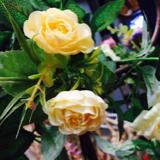
倒挂金钟(拉丁学名:Fuchsia hybrida Hort. ex Sieb. et Voss),别名:灯笼花、吊钟海棠。多年生半灌木,茎直立。高50-200厘米,粗6-20毫米,多分枝,被短柔毛与腺毛,老时渐变无毛,幼枝带红色。叶对生,卵形或狭卵形,长3-9厘米,宽2.5-5厘米。喜凉爽湿润环境,怕高温和强光,以肥沃、疏松的微酸性壤土为宜,冬季温度不低于5℃。
原产墨西哥,广泛栽培于全世界,在中国广为栽培,尤在北方或在西北、西南高原温室种植。盆栽适用于客室、花架、案头点缀,用清水插瓶,既可观赏,又可生根繁殖。
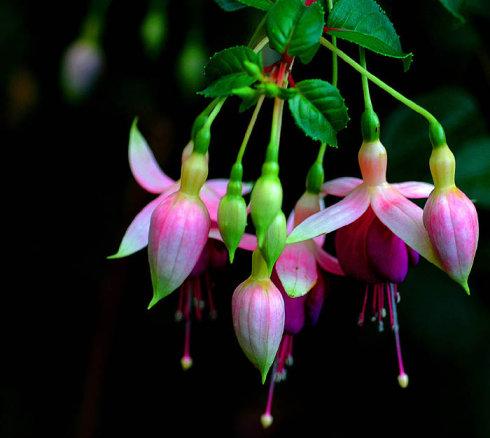
倒挂金钟烂根的原因
浇水过多
这是最常见的原因,倒挂金钟喜欢湿润的环境,但并不需要经常性的浇水,若浇水过多,造成盆土过于潮湿,环境又闷热,水分蒸发不掉,根部在潮湿的环境中,呼吸受阻,会阻碍营养的吸收,不仅会导致烂根,还会影响整株植株的生长。
施肥量过大
倒挂金钟烂根的原因是施肥不当造成的,也就是我们常说的肥害。有可能是一次性施入的肥量过大,植株难以吸收,还有一种情况是施入生肥,肥料中的有机质未经发酵,或者是腐熟程度不够,都会造成植株无法吸收,反而会腐蚀根系,造成烂根。
病害威胁
烂根还可能是因为病害,在种植时土壤未经消毒,或种植了带病的植株,或者浇水的水质被污染,携带病菌,土壤中存在大量的病菌,会慢慢感染植株,形成病害,造成烂根。
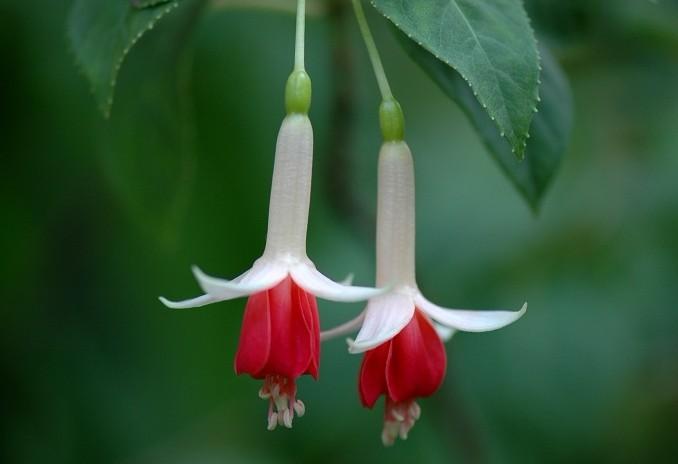
倒挂金钟烂根怎么办
用排水良好的新土栽培倒挂金钟,有病菌的土应进行蒸气灭菌,如果不确定到底有没有病菌,建议在春天的时候,结合翻盆,直接全部消一下毒,或者全部换新。
科学浇水。宜小水勤灌,忌大水谩灌。盆土长期过湿,根系窒息,也易发生腐烂。
烂根不易被人察觉,但发现植株的长势不好,表面有没有什么病斑,可以考虑一下是不是烂根了。及时将植株取出,将腐烂部分清除,然后抹上多菌灵重新栽种。
原产墨西哥,广泛栽培于全世界,在中国广为栽培,尤在北方或在西北、西南高原温室种植。盆栽适用于客室、花架、案头点缀,用清水插瓶,既可观赏,又可生根繁殖。

倒挂金钟烂根的原因
浇水过多
这是最常见的原因,倒挂金钟喜欢湿润的环境,但并不需要经常性的浇水,若浇水过多,造成盆土过于潮湿,环境又闷热,水分蒸发不掉,根部在潮湿的环境中,呼吸受阻,会阻碍营养的吸收,不仅会导致烂根,还会影响整株植株的生长。
施肥量过大
倒挂金钟烂根的原因是施肥不当造成的,也就是我们常说的肥害。有可能是一次性施入的肥量过大,植株难以吸收,还有一种情况是施入生肥,肥料中的有机质未经发酵,或者是腐熟程度不够,都会造成植株无法吸收,反而会腐蚀根系,造成烂根。
病害威胁
烂根还可能是因为病害,在种植时土壤未经消毒,或种植了带病的植株,或者浇水的水质被污染,携带病菌,土壤中存在大量的病菌,会慢慢感染植株,形成病害,造成烂根。

倒挂金钟烂根怎么办
用排水良好的新土栽培倒挂金钟,有病菌的土应进行蒸气灭菌,如果不确定到底有没有病菌,建议在春天的时候,结合翻盆,直接全部消一下毒,或者全部换新。
科学浇水。宜小水勤灌,忌大水谩灌。盆土长期过湿,根系窒息,也易发生腐烂。
烂根不易被人察觉,但发现植株的长势不好,表面有没有什么病斑,可以考虑一下是不是烂根了。及时将植株取出,将腐烂部分清除,然后抹上多菌灵重新栽种。
0
1
文章
Dummer. ゛☀
2017年07月27日

Family - Polemoniaceae
Stems - To -1m tall, erect, herbaceous, perennial, from a small woody caudex and slightly thickened roots, terete, glabrescent basally, densely glandular pubescent apically, simple, one or two from base, with 6-15 nodes per stem. Some of the hairs along the length of the stem stellate also.
Leaves - Opposite, decussate, sessile or short petiolate (the petioles obscured by decurrent leaf tissue), to +/-10cm long, +/-5cm broad, ovate to lanceolate, entire, acute to acuminate, pubescent and slightly scabrous adaxially, villosuous abaxially, dark green adaxially, light green abaxially. Veins of the leaf impressed adaxially, expressed abaxially, anastomosing.
Inflorescence - Terminal and lateral cymes from the upper leaf axils, to +/-10cm long (tall). Each division of cyme subtended by a pair of linear bracts. Bracts reduced upward. Branches of inflorescence and bracts densely glandular pubescent. Pedicels to 5mm long.
Flowers - Corolla lilac to pinkish, 5-lobed, glabrous. Tube to +3cm long. Lobes spreading, obovate, blunt at the apex, to 1cm long and broad. Stamens 5, included. Anthers yellow-orange, 3mm long, 1mm broad. Ovary superior, green, ovoid, 1.5-2mm long in flower, 1mm in diameter. Calyx densely glandular pubescent externally, glabrous internally. Calyx tube to 4-5mm long in flower, 5-lobed. Lobes attenuate, 3-4mm long, connected at the base by scarious tissue and helping to form the calyx tube.
Flowering - May - August.
Habitat - Rich, rocky, or alluvial woods, slopes along streams.
Origin - Native to U.S.
Other info. - This striking species is fairly uncommon in Missouri. It is found in just a handful of counties in the Ozarks.
P. amplifolia can be identified by its long corolla tubes, its broad, pubescent leaves, and its pubescent stems. This species is a perennial and would make a good garden subject if the right conditions were provided.
Stems - To -1m tall, erect, herbaceous, perennial, from a small woody caudex and slightly thickened roots, terete, glabrescent basally, densely glandular pubescent apically, simple, one or two from base, with 6-15 nodes per stem. Some of the hairs along the length of the stem stellate also.

Leaves - Opposite, decussate, sessile or short petiolate (the petioles obscured by decurrent leaf tissue), to +/-10cm long, +/-5cm broad, ovate to lanceolate, entire, acute to acuminate, pubescent and slightly scabrous adaxially, villosuous abaxially, dark green adaxially, light green abaxially. Veins of the leaf impressed adaxially, expressed abaxially, anastomosing.

Inflorescence - Terminal and lateral cymes from the upper leaf axils, to +/-10cm long (tall). Each division of cyme subtended by a pair of linear bracts. Bracts reduced upward. Branches of inflorescence and bracts densely glandular pubescent. Pedicels to 5mm long.
Flowers - Corolla lilac to pinkish, 5-lobed, glabrous. Tube to +3cm long. Lobes spreading, obovate, blunt at the apex, to 1cm long and broad. Stamens 5, included. Anthers yellow-orange, 3mm long, 1mm broad. Ovary superior, green, ovoid, 1.5-2mm long in flower, 1mm in diameter. Calyx densely glandular pubescent externally, glabrous internally. Calyx tube to 4-5mm long in flower, 5-lobed. Lobes attenuate, 3-4mm long, connected at the base by scarious tissue and helping to form the calyx tube.

Flowering - May - August.
Habitat - Rich, rocky, or alluvial woods, slopes along streams.
Origin - Native to U.S.
Other info. - This striking species is fairly uncommon in Missouri. It is found in just a handful of counties in the Ozarks.
P. amplifolia can be identified by its long corolla tubes, its broad, pubescent leaves, and its pubescent stems. This species is a perennial and would make a good garden subject if the right conditions were provided.
0
0
文章
Colour_
2017年07月27日

水晶掌(Haworthia cymbiformis var.triebnet poelln),是百合科十二卷属的多肉植物,原产南非。植株矮小,株高一般5~6厘米。叶形叶色较美,有一定的观赏价值。
形态特征
植株矮小,株高一般5~6厘米。叶片互生,长圆形或匙状,肉质肥厚,生于极短的茎上,紧密排列为莲座状,叶色翠绿色,叶肉呈半透明状,叶面有8~12条暗褐色条纹或中间有褐色、青色的斑块,叶缘粉红色,有细锯齿。顶生总状花序,花极小。是常见的多肉植物之一。
水晶掌常为雌雄同株,花两性。花葶纤细,自叶簇中央的叶腋间抽生而出,大大超过叶簇。顶生总状花序,花极小,无观赏价值,开花后叶簇显得松散。
生长习性
喜温暖而湿润及半荫的环境,耐干旱,忌炎热,不耐寒,生长适温为20~25℃,要求肥沃、排水良好的沙质土壤。
繁殖方法
以分株法繁殖,每年3月开始长出侧芽,此时应换用大盆,生长条件不同侧芽数量差别很大,从4-9株不等,繁殖时把侧芽掰下来插入土中即可。
实践证明侧芽本身长出6-8片叶片后是分株的最佳时间,此时侧芽根较浅易于分离,且生存率显著提高。新上盆的植株浇水不要太多,以免引起腐烂,但需要保持湿润,等新根长出后才能正常浇水。
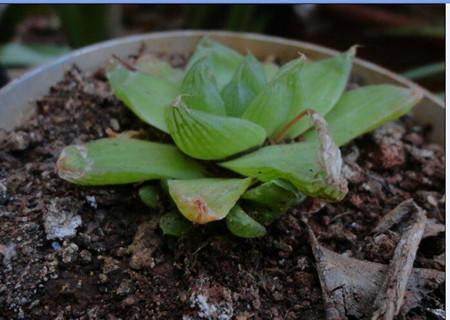
水晶掌为什么会烂根呢
水晶掌是肉质植物,本身比较耐干旱和高温,但是在浇水浇多了的情况下,是会出现烂根的,还可能导致叶片腐烂。
另外,出现烂根也有可能是土壤和施肥不当的缘故。因为水晶掌喜欢疏松肥沃的排水性良好的土壤,土壤的通透性差也很容易腐烂。施肥不当则主要是因为在施肥的时候不小心沾污了根部或者是叶子,导致出现烂根和叶片腐烂的现象。

水晶掌出现烂根要怎么办
水晶掌如果出现了烂根,首先要把已经烂掉的根部或者是化水的根部和叶子处理掉,可以将腐烂的部分切掉,然后将伤口晾干,重新上盆换土养殖。还有一种方法就是进行分株繁殖,在出现烂根的情况下,可以将水晶掌生长比较完好的侧芽取下来进行栽植即可。
不过,水晶掌的烂根问题,最根本的还是要做好预防,预防主要就是要合理的浇水。在平时的时候,浇水就不能太多,一般盆土不干不浇即可。但是有时候植株也会缺水,此时不需要浇太多的水,及时的补水并向植株喷水,在夏季高温的时候植株会进行半休眠的状态,除了要减少浇水,还需要加强通风,可以避免根部和嫩叶的腐烂,有时还需及时的将盆内的积水排掉。
形态特征
植株矮小,株高一般5~6厘米。叶片互生,长圆形或匙状,肉质肥厚,生于极短的茎上,紧密排列为莲座状,叶色翠绿色,叶肉呈半透明状,叶面有8~12条暗褐色条纹或中间有褐色、青色的斑块,叶缘粉红色,有细锯齿。顶生总状花序,花极小。是常见的多肉植物之一。
水晶掌常为雌雄同株,花两性。花葶纤细,自叶簇中央的叶腋间抽生而出,大大超过叶簇。顶生总状花序,花极小,无观赏价值,开花后叶簇显得松散。
生长习性
喜温暖而湿润及半荫的环境,耐干旱,忌炎热,不耐寒,生长适温为20~25℃,要求肥沃、排水良好的沙质土壤。
繁殖方法
以分株法繁殖,每年3月开始长出侧芽,此时应换用大盆,生长条件不同侧芽数量差别很大,从4-9株不等,繁殖时把侧芽掰下来插入土中即可。
实践证明侧芽本身长出6-8片叶片后是分株的最佳时间,此时侧芽根较浅易于分离,且生存率显著提高。新上盆的植株浇水不要太多,以免引起腐烂,但需要保持湿润,等新根长出后才能正常浇水。

水晶掌为什么会烂根呢
水晶掌是肉质植物,本身比较耐干旱和高温,但是在浇水浇多了的情况下,是会出现烂根的,还可能导致叶片腐烂。
另外,出现烂根也有可能是土壤和施肥不当的缘故。因为水晶掌喜欢疏松肥沃的排水性良好的土壤,土壤的通透性差也很容易腐烂。施肥不当则主要是因为在施肥的时候不小心沾污了根部或者是叶子,导致出现烂根和叶片腐烂的现象。

水晶掌出现烂根要怎么办
水晶掌如果出现了烂根,首先要把已经烂掉的根部或者是化水的根部和叶子处理掉,可以将腐烂的部分切掉,然后将伤口晾干,重新上盆换土养殖。还有一种方法就是进行分株繁殖,在出现烂根的情况下,可以将水晶掌生长比较完好的侧芽取下来进行栽植即可。
不过,水晶掌的烂根问题,最根本的还是要做好预防,预防主要就是要合理的浇水。在平时的时候,浇水就不能太多,一般盆土不干不浇即可。但是有时候植株也会缺水,此时不需要浇太多的水,及时的补水并向植株喷水,在夏季高温的时候植株会进行半休眠的状态,除了要减少浇水,还需要加强通风,可以避免根部和嫩叶的腐烂,有时还需及时的将盆内的积水排掉。
0
0
文章
Colour_
2017年07月25日

变叶木灌木或小乔木。色彩鲜艳、光亮。常盆栽,原产马来西亚及太平洋地区。可高达6公尺(20尺)。叶片含花青素,单色或绿、黄、白、橙、红、粉红、大红及紫等,诸色相杂叶长10~15公分(4~6寸),形态因品种不同而异,呈细长线形、披针形、卵形或有深裂。变叶木以其叶片形色而得名,其叶形有披针形、卵形、椭圆形,还有波浪起伏状、扭曲状等等。其叶色有亮绿色、白色、灰色、红色、淡红色、深红色、紫色、黄色、黄红色等等。
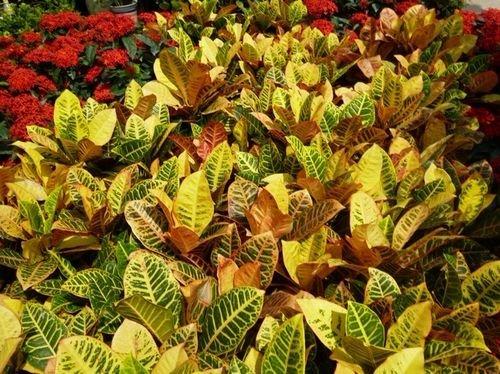
洒金榕掉叶子原因
1.温度不当
在养殖洒金榕的时候,需要给予它一个温暖的环境。洒金榕喜欢温暖并且不耐寒,它的生长的适宜温度是在20℃——30℃之间,在冬季的时候环境的温度最好也不要太低了。
在冬季的时候,如果短时间内,洒金榕的温度保持在10℃左右,就会使其出现叶子不鲜艳并且缺乏光泽的现象。如果养护的温度在4℃——5℃的时候,洒金榕就会出现冻害,叶子受冻。导致其大量的掉叶子,甚至是冻死。
所以在养殖洒金榕的时候,冬季一定要保持较高的温度,在进行养护的时候,温度不要低于13℃。
2.浇水不足
洒金榕是喜欢湿润的植物,在进行养殖的时候,一定要给予洒金榕充足的水分,并且需要经常向洒金榕的植株来喷水,提高空气湿度。不过在冬季的时候,因为温度比较低,所以需要保持干燥,此时植株已经进入了半休眠的状态,如果浇水太多的话,就会导致洒金榕掉叶子了。
在给洒金榕浇水的时候,一定要注意在冬季的时候,浇水不能太多了。
3.光照不足
洒金榕是喜欢光照的植物,在养殖洒金榕的时候一定要在其生长期间满足它对光照的需求,这样它才会生长良好。不过在室内养殖的时候,光照的条件可能不会很好,如果长时间光照不足的话,就会使洒金榕叶子颜色暗淡,缺少光泽,甚至会掉叶子。所以在养殖洒金榕的时候,光照一定要充足,在室内也要放在可以接触到阳光的地方进行养护。


洒金榕掉叶子原因
1.温度不当
在养殖洒金榕的时候,需要给予它一个温暖的环境。洒金榕喜欢温暖并且不耐寒,它的生长的适宜温度是在20℃——30℃之间,在冬季的时候环境的温度最好也不要太低了。
在冬季的时候,如果短时间内,洒金榕的温度保持在10℃左右,就会使其出现叶子不鲜艳并且缺乏光泽的现象。如果养护的温度在4℃——5℃的时候,洒金榕就会出现冻害,叶子受冻。导致其大量的掉叶子,甚至是冻死。
所以在养殖洒金榕的时候,冬季一定要保持较高的温度,在进行养护的时候,温度不要低于13℃。
2.浇水不足
洒金榕是喜欢湿润的植物,在进行养殖的时候,一定要给予洒金榕充足的水分,并且需要经常向洒金榕的植株来喷水,提高空气湿度。不过在冬季的时候,因为温度比较低,所以需要保持干燥,此时植株已经进入了半休眠的状态,如果浇水太多的话,就会导致洒金榕掉叶子了。
在给洒金榕浇水的时候,一定要注意在冬季的时候,浇水不能太多了。
3.光照不足
洒金榕是喜欢光照的植物,在养殖洒金榕的时候一定要在其生长期间满足它对光照的需求,这样它才会生长良好。不过在室内养殖的时候,光照的条件可能不会很好,如果长时间光照不足的话,就会使洒金榕叶子颜色暗淡,缺少光泽,甚至会掉叶子。所以在养殖洒金榕的时候,光照一定要充足,在室内也要放在可以接触到阳光的地方进行养护。

0
0
文章
Dummer. ゛☀
2017年07月24日

Family - Asteraceae
Stems - To +1m tall, from horizontal rhizomes (deep), glabrous or very sparse pubescent at base, striate, herbaceous, erect, branching near apex, hollow.
Leaves - Alternate, to -15cm long, 6-7cm broad, sessile, pinnately lobed, with spines on margins, sparse arachnoid pubescent (mostly on lobes below). Upper leaves less lobed to serrate.
Inflorescence - Single terminal flower heads in loose corymbiform arrangement. Branches of inflorescence (peduncles) arachnoid pubescent.
Involucre - To 1.5cm tall (long), 8-9mm in diameter, suburceolate. Phyllaries imbricate, appressed, with dark purple tips. Tips acute, to 1mm long, slightly spreading. Innermost phyllaries to 1.1cm long, 1.5mm broad, glabrous, with scarious margins. Outer phyllaries with sparse to moderate arachnoid pubescence.
Ray flowers - Absent.
Disk flowers - Corolla pink, 5-lobed. Lobes 2.5-3mm long, linear, thickened at apex with small protuberance. Corolla tube 1.1cm long, lilac-whitish. Achenes to 2mm long, glabrous, white(in flower) terete to weakly 4-angled. Pappus of dense plumose bristles to 1cm long. Receptacle flat.
Flowering - June - October.
Habitat - Fields, waste ground, roadsides, railroads.
Origin - Native to Europe.
Other info. - This is a nasty little plant. It is not too common in Missouri yet but most certainly will be soon. It is very common in states to the north and east. The plant is considered a noxious weed and should not be spread. It is quite aggressive and because of its deep rhizomes is very hard to eradicate.
C. arvense is dioecious and the flower heads are quite variable depending on if they are staminate or pistillate. The species can also vary on pubescence, flower color, and leaf shape. A white-flowered form, form albiflorum (Rand & Redf.), has not yet been reported from Missouri.
Stems - To +1m tall, from horizontal rhizomes (deep), glabrous or very sparse pubescent at base, striate, herbaceous, erect, branching near apex, hollow.

Leaves - Alternate, to -15cm long, 6-7cm broad, sessile, pinnately lobed, with spines on margins, sparse arachnoid pubescent (mostly on lobes below). Upper leaves less lobed to serrate.

Inflorescence - Single terminal flower heads in loose corymbiform arrangement. Branches of inflorescence (peduncles) arachnoid pubescent.
Involucre - To 1.5cm tall (long), 8-9mm in diameter, suburceolate. Phyllaries imbricate, appressed, with dark purple tips. Tips acute, to 1mm long, slightly spreading. Innermost phyllaries to 1.1cm long, 1.5mm broad, glabrous, with scarious margins. Outer phyllaries with sparse to moderate arachnoid pubescence.

Ray flowers - Absent.
Disk flowers - Corolla pink, 5-lobed. Lobes 2.5-3mm long, linear, thickened at apex with small protuberance. Corolla tube 1.1cm long, lilac-whitish. Achenes to 2mm long, glabrous, white(in flower) terete to weakly 4-angled. Pappus of dense plumose bristles to 1cm long. Receptacle flat.
Flowering - June - October.
Habitat - Fields, waste ground, roadsides, railroads.
Origin - Native to Europe.
Other info. - This is a nasty little plant. It is not too common in Missouri yet but most certainly will be soon. It is very common in states to the north and east. The plant is considered a noxious weed and should not be spread. It is quite aggressive and because of its deep rhizomes is very hard to eradicate.
C. arvense is dioecious and the flower heads are quite variable depending on if they are staminate or pistillate. The species can also vary on pubescence, flower color, and leaf shape. A white-flowered form, form albiflorum (Rand & Redf.), has not yet been reported from Missouri.
0
0
文章
Dummer. ゛☀
2017年07月24日

Family - Rubiaceae
Stems - Multiple from the base, sprawling to ascending, to +40cm long, herbaceous, 4-angled, hispidulous below, glabrescent apically.
Leaves - Sessile, in whorls of 6, oblong, to +/-8mm long, 3-4mm broad, pubescent adaxially and ciliate on the midrib abaxially, entire, acute, with strigillose margins. The margin of the leaf translucent at least at the apex (use a lens to see). Lowest leaves obovate to oblanceolate.
Inflorescence - Axillary bracteate fascicles of typically 3 flowers. Peduncles to 1cm long in fruit, 1-2mm long in flower, 4-angled, glabrous to sparse pubescent. Bracts subtending the flowers foliaceous, accrescent, lanceolate, 3-nerved, to 8mm long and 3mm broad in fruit, strigose externally, glabrous internally.
Flowers - Corolla 4-lobed, funnelform, 4-5mm long, pinkish-purple. Corolla tube to 3mm long, whitish at the base, glabrous externally and internally. Corolla lobes acute, spreading, -2mm long, 1mm broad, glabrous. Stamens 4, exserted, adnate at the apex of the corolla tube. Filaments white, glabrous, 1.1mm long. Anthers purplish, .3mm long. Style exserted, glabrous, translucent, 4mm long. Stigmas 2, short (.1mm long). Calyx 1.1mm long in flower, accrescent, 6-lobed, pubescent, green. Calyx lobes triangular, .3mm long. Fruits mostly on stalks to .5mm long, pubescent. slightly rectangular in cross-section, to 4mm long, 2-locular, 2-seeded.
Flowering - April - May.
Habitat - Openings in woods, along creeks, disturbed sites, fields, roadsides.
Origin - Native to Europe.
Other info. - This little species is uncommon in Missouri. It is found only in several southwestern counties. The plant, at first glance, appears to be in the genus Galium but its purplish flowers, funnelform corolla and bracteate inflorescences separate it from that genus. The plant can be quite weedy if left un-checked and it will most certainly expand its range in Missouri with time.
Stems - Multiple from the base, sprawling to ascending, to +40cm long, herbaceous, 4-angled, hispidulous below, glabrescent apically.

Leaves - Sessile, in whorls of 6, oblong, to +/-8mm long, 3-4mm broad, pubescent adaxially and ciliate on the midrib abaxially, entire, acute, with strigillose margins. The margin of the leaf translucent at least at the apex (use a lens to see). Lowest leaves obovate to oblanceolate.

Inflorescence - Axillary bracteate fascicles of typically 3 flowers. Peduncles to 1cm long in fruit, 1-2mm long in flower, 4-angled, glabrous to sparse pubescent. Bracts subtending the flowers foliaceous, accrescent, lanceolate, 3-nerved, to 8mm long and 3mm broad in fruit, strigose externally, glabrous internally.

Flowers - Corolla 4-lobed, funnelform, 4-5mm long, pinkish-purple. Corolla tube to 3mm long, whitish at the base, glabrous externally and internally. Corolla lobes acute, spreading, -2mm long, 1mm broad, glabrous. Stamens 4, exserted, adnate at the apex of the corolla tube. Filaments white, glabrous, 1.1mm long. Anthers purplish, .3mm long. Style exserted, glabrous, translucent, 4mm long. Stigmas 2, short (.1mm long). Calyx 1.1mm long in flower, accrescent, 6-lobed, pubescent, green. Calyx lobes triangular, .3mm long. Fruits mostly on stalks to .5mm long, pubescent. slightly rectangular in cross-section, to 4mm long, 2-locular, 2-seeded.
Flowering - April - May.
Habitat - Openings in woods, along creeks, disturbed sites, fields, roadsides.
Origin - Native to Europe.
Other info. - This little species is uncommon in Missouri. It is found only in several southwestern counties. The plant, at first glance, appears to be in the genus Galium but its purplish flowers, funnelform corolla and bracteate inflorescences separate it from that genus. The plant can be quite weedy if left un-checked and it will most certainly expand its range in Missouri with time.
0
0
文章
丫头
2017年07月20日

露台种什么植物好,由于露台种#葡萄 的方法也不是很难,所以有花友会选择葡萄,其实露台和阳台都可以种葡萄,只要保证有一定土量,有6-8小时以上的日照即可。
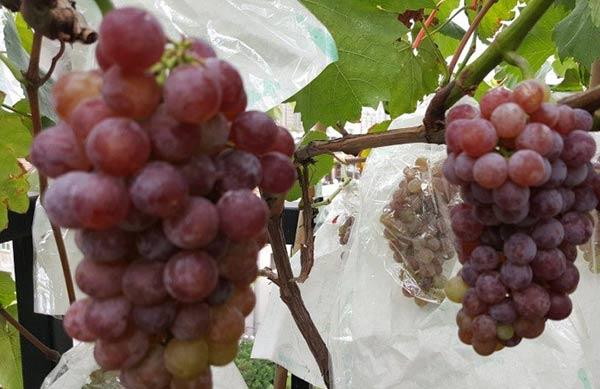
如果选择葡萄速产品种,头年种,第二年就有果吃。下面,以时间顺序告诉你,怎么从零开始种葡萄。种植的地点假设是长江流域以南,北方的朋友在种植时间上可能会稍微推后。
第一年
1月份买苗种植(或者上一年12月买也可)。
关于土:种植土越多越好,有花池最好,没有的话用泡沫箱拼起来种。土可以事先准备好,最好用大量的杂草树叶打底,上面用园土,掺五分之一的锯末或者珍珠岩以保证疏松透气。种苗的土不能太肥,土要压实让根紧密接触土。
关于苗:某宝上的什么5年大苗8年大苗之类全是忽悠你的,种葡萄最好就是用1年苗,这样苗长势旺,第二年就可以结果,第3年开始丰产。很多老树一般是葡萄园淘汰下来的,树势衰弱,根不好,将来种了后难丰产。
葡萄长三年就是树了,可有3指粗,所以某宝上买个5年苗,寄过来只有1个指头初粗,那更是骗死你不偿命。苗买回来是光杆,把它种下去,浇透水就行了,这时候天气寒冷,不用多浇水,只要土壤不太干就行。
新手或者雨水多的地方,可选好种的品种,巨峰夏黑寒香蜜白香蕉摩尔多瓦雨水红之类都可以。其中摩尔多瓦是很容易有成就感的品种,容易结果且不容易生病,也没有落果落花裂果等毛病,只是口感偏淡一点,要注意这个品种先上色再上糖,所以变黑后再挂上一个月才好吃,这时候就比较甜了。
4月-5月:
4月初苗开始发芽,注意买的苗一般是嫁接苗,在嫁接口处有塑料膜绑着,苗发芽后要去掉塑料膜。嫁接口以下发出来的芽要全部去掉,上面发出来的芽选一个壮枝保留,其余全部去掉。
这个枝长出8片叶子后,摘心。摘心后很多叶子根部会发出芽来,只留最顶上一个芽让它长成主枝,其余的芽留2片叶子打顶。这个芽叫夏芽,因为它是夏天发出。每片叶子根部还有另外一个芽,这个芽今年不会萌发,会在来年春天发,这个芽叫冬芽。冬芽就是明年结果枝的芽,摘心的目的就是要让它养壮。最顶上的夏芽反复不断摘心,每次留7、6、5、4片叶子反复摘心。如果你是花池栽,葡萄长得粗,那么可以多留几根夏芽发出来的枝作为主枝,按照8、7、6....的方法反复摘心也行。
苗开始长出卷须来后可以开始施肥,施少量氮肥,尿素融水就行,要薄肥勤施,千万不要把葡萄肥死了。苗长大后每周一次用复合肥融水施就可以,当然也可以加饼肥、鸡粪等有机肥,注意适量。5月份叶片长大后,可以喷页面肥,用尿素和磷酸二氢钾融水,都是千分之2浓度就可以了,重点喷叶的背面,正面也喷点。葡萄所有的卷须都要剪掉,避免耗费营养,另外用绳子把葡萄枝绑在架子上。
下图是我15年种的1年苗,这是寒香蜜,注意看红圈是嫁接口,红圈以下的那根枝要去掉,只留上面的那一个芽。这样小小的一根苗,16年就能结出大量的果子。

6月
开始进入梅雨季节,要做好葡萄的防病,可以用波尔多液喷叶片正反面,特别是下大雨前要喷,连续阴雨后要喷。把露台环境弄干净,不要到处是残枝落叶,那样容易产生病菌。
7月
葡萄这时进入花芽分化期,这是明年能否丰收的关键。土里少量施硼酸和硫酸锌,另外再用磷酸二氢钾加尿素溶液喷叶,最好10天一次。磷酸二氢钾注意要买正品,花鸟市场里90%的是假的,可上某宝买国光牌的。
8月-11月8月到9月酷暑季节,要注意葡萄的浇水,露台上一般要早晚各一次,保证不缺水。10月到11月,葡萄再次进入长根期,这时候还是注意薄肥勤施,经常用千分之二磷酸二氢钾溶液浇灌,可以促根。但是切记切记不要浓了,新手最容易犯的错就是肥死葡萄。到11月份,可以在离葡萄根30公分远的地方,挖坑埋入鱼肠之类的荤肥,葡萄最喜欢,来年葡萄又大又甜。如果是泡沫箱种,那就在箱子边上少量埋点鱼肠,或者煮熟的鸡蛋打个小孔,埋土里也可。
12月
葡萄叶子掉光后,开始剪枝。今年培养的主枝,每根主枝留底部5-6个芽,其余上面的枝子剪去。如果是独杆主枝,可以多留点芽。
第二年
4月份葡萄开始发芽,这时候,去年的冬芽发出来,会有花穗。如下图所示(图中是巨峰的花穗):

花穗出来后,特别要注意的就是保花保果。注意以下几点:
一是发芽后到出现花穗时要尽量少用氮肥,如果去年的葡萄壮,有机肥施得足,可以不用氮肥,如果不是很壮,发芽时施一次尿素溶液即可,后面不要施了,另外花期要少浇水,保持土不干即可。水多了,氮肥多了容易落花。
二是注意叶面喷硼肥和锌肥,用千分之2到3的浓度,10天一次,喷2-3次。另外还可喷磷酸二氢钾等叶面肥。
三是要注意防病,这时灰霉病和穗轴褐枯病是葡萄落花的两大杀手,花穗长到6-7公分长后,可在花上喷一次凯泽防病。
5月份
这时葡萄开花了,对于寒香蜜摩尔多瓦白香蕉等品种来说,可以不用管它,自然坐果很好。如果是巨峰夏黑巨玫瑰红富士等巨峰系的品种,由于品种特点就是落花落果,所以要注意保果。可以用某宝上的美国奇宝来保果。它其实就是赤霉酸,是安全的,它是生物提炼的,也是国家最高档次AA级绿色农产品标准允许使用的。如果你担心,想一想用一瓶啤酒,让它的水分蒸发掉90%,剩下的溶液用来保果,是一样的效果,因为这时剩下的溶液就是百万分之二十浓度的赤霉酸(啤酒里含百万分之二的赤霉酸)。下面是奇宝,一包有200毫克赤霉酸,溶解到20斤水里面,就是百万分之二十浓度赤霉酸。
葡萄一穗花全开时,喷赤霉酸一次,12天后再喷一次就可以了。
6月份
葡萄结出小果实了,这时可以在果穗上喷一次波尔多液保护,然后就可以套袋了。套袋的作用是防病和防鸟。葡萄坐果坐稳后,就要大肥大水,促进葡萄果实增大,这时候要多施速效氮肥,可以用尿素水浇施。
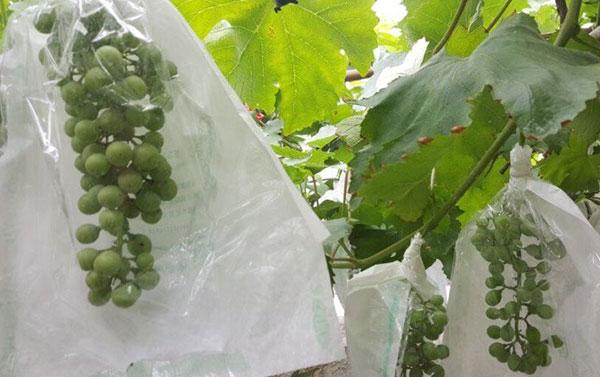
6月中旬-8月
这是葡萄果实成熟的季节,想要葡萄甜,上色好,就要注意多施钾肥,一是注意多用鸡粪,二是可以用磷酸二氢钾喷叶,或者高钾水溶肥浇灌。这样葡萄就可以长得漂亮又甜。


如果选择葡萄速产品种,头年种,第二年就有果吃。下面,以时间顺序告诉你,怎么从零开始种葡萄。种植的地点假设是长江流域以南,北方的朋友在种植时间上可能会稍微推后。
第一年
1月份买苗种植(或者上一年12月买也可)。
关于土:种植土越多越好,有花池最好,没有的话用泡沫箱拼起来种。土可以事先准备好,最好用大量的杂草树叶打底,上面用园土,掺五分之一的锯末或者珍珠岩以保证疏松透气。种苗的土不能太肥,土要压实让根紧密接触土。
关于苗:某宝上的什么5年大苗8年大苗之类全是忽悠你的,种葡萄最好就是用1年苗,这样苗长势旺,第二年就可以结果,第3年开始丰产。很多老树一般是葡萄园淘汰下来的,树势衰弱,根不好,将来种了后难丰产。
葡萄长三年就是树了,可有3指粗,所以某宝上买个5年苗,寄过来只有1个指头初粗,那更是骗死你不偿命。苗买回来是光杆,把它种下去,浇透水就行了,这时候天气寒冷,不用多浇水,只要土壤不太干就行。
新手或者雨水多的地方,可选好种的品种,巨峰夏黑寒香蜜白香蕉摩尔多瓦雨水红之类都可以。其中摩尔多瓦是很容易有成就感的品种,容易结果且不容易生病,也没有落果落花裂果等毛病,只是口感偏淡一点,要注意这个品种先上色再上糖,所以变黑后再挂上一个月才好吃,这时候就比较甜了。
4月-5月:
4月初苗开始发芽,注意买的苗一般是嫁接苗,在嫁接口处有塑料膜绑着,苗发芽后要去掉塑料膜。嫁接口以下发出来的芽要全部去掉,上面发出来的芽选一个壮枝保留,其余全部去掉。
这个枝长出8片叶子后,摘心。摘心后很多叶子根部会发出芽来,只留最顶上一个芽让它长成主枝,其余的芽留2片叶子打顶。这个芽叫夏芽,因为它是夏天发出。每片叶子根部还有另外一个芽,这个芽今年不会萌发,会在来年春天发,这个芽叫冬芽。冬芽就是明年结果枝的芽,摘心的目的就是要让它养壮。最顶上的夏芽反复不断摘心,每次留7、6、5、4片叶子反复摘心。如果你是花池栽,葡萄长得粗,那么可以多留几根夏芽发出来的枝作为主枝,按照8、7、6....的方法反复摘心也行。
苗开始长出卷须来后可以开始施肥,施少量氮肥,尿素融水就行,要薄肥勤施,千万不要把葡萄肥死了。苗长大后每周一次用复合肥融水施就可以,当然也可以加饼肥、鸡粪等有机肥,注意适量。5月份叶片长大后,可以喷页面肥,用尿素和磷酸二氢钾融水,都是千分之2浓度就可以了,重点喷叶的背面,正面也喷点。葡萄所有的卷须都要剪掉,避免耗费营养,另外用绳子把葡萄枝绑在架子上。
下图是我15年种的1年苗,这是寒香蜜,注意看红圈是嫁接口,红圈以下的那根枝要去掉,只留上面的那一个芽。这样小小的一根苗,16年就能结出大量的果子。

6月
开始进入梅雨季节,要做好葡萄的防病,可以用波尔多液喷叶片正反面,特别是下大雨前要喷,连续阴雨后要喷。把露台环境弄干净,不要到处是残枝落叶,那样容易产生病菌。
7月
葡萄这时进入花芽分化期,这是明年能否丰收的关键。土里少量施硼酸和硫酸锌,另外再用磷酸二氢钾加尿素溶液喷叶,最好10天一次。磷酸二氢钾注意要买正品,花鸟市场里90%的是假的,可上某宝买国光牌的。
8月-11月8月到9月酷暑季节,要注意葡萄的浇水,露台上一般要早晚各一次,保证不缺水。10月到11月,葡萄再次进入长根期,这时候还是注意薄肥勤施,经常用千分之二磷酸二氢钾溶液浇灌,可以促根。但是切记切记不要浓了,新手最容易犯的错就是肥死葡萄。到11月份,可以在离葡萄根30公分远的地方,挖坑埋入鱼肠之类的荤肥,葡萄最喜欢,来年葡萄又大又甜。如果是泡沫箱种,那就在箱子边上少量埋点鱼肠,或者煮熟的鸡蛋打个小孔,埋土里也可。
12月
葡萄叶子掉光后,开始剪枝。今年培养的主枝,每根主枝留底部5-6个芽,其余上面的枝子剪去。如果是独杆主枝,可以多留点芽。
第二年
4月份葡萄开始发芽,这时候,去年的冬芽发出来,会有花穗。如下图所示(图中是巨峰的花穗):

花穗出来后,特别要注意的就是保花保果。注意以下几点:
一是发芽后到出现花穗时要尽量少用氮肥,如果去年的葡萄壮,有机肥施得足,可以不用氮肥,如果不是很壮,发芽时施一次尿素溶液即可,后面不要施了,另外花期要少浇水,保持土不干即可。水多了,氮肥多了容易落花。
二是注意叶面喷硼肥和锌肥,用千分之2到3的浓度,10天一次,喷2-3次。另外还可喷磷酸二氢钾等叶面肥。
三是要注意防病,这时灰霉病和穗轴褐枯病是葡萄落花的两大杀手,花穗长到6-7公分长后,可在花上喷一次凯泽防病。
5月份
这时葡萄开花了,对于寒香蜜摩尔多瓦白香蕉等品种来说,可以不用管它,自然坐果很好。如果是巨峰夏黑巨玫瑰红富士等巨峰系的品种,由于品种特点就是落花落果,所以要注意保果。可以用某宝上的美国奇宝来保果。它其实就是赤霉酸,是安全的,它是生物提炼的,也是国家最高档次AA级绿色农产品标准允许使用的。如果你担心,想一想用一瓶啤酒,让它的水分蒸发掉90%,剩下的溶液用来保果,是一样的效果,因为这时剩下的溶液就是百万分之二十浓度的赤霉酸(啤酒里含百万分之二的赤霉酸)。下面是奇宝,一包有200毫克赤霉酸,溶解到20斤水里面,就是百万分之二十浓度赤霉酸。
葡萄一穗花全开时,喷赤霉酸一次,12天后再喷一次就可以了。
6月份
葡萄结出小果实了,这时可以在果穗上喷一次波尔多液保护,然后就可以套袋了。套袋的作用是防病和防鸟。葡萄坐果坐稳后,就要大肥大水,促进葡萄果实增大,这时候要多施速效氮肥,可以用尿素水浇施。

6月中旬-8月
这是葡萄果实成熟的季节,想要葡萄甜,上色好,就要注意多施钾肥,一是注意多用鸡粪,二是可以用磷酸二氢钾喷叶,或者高钾水溶肥浇灌。这样葡萄就可以长得漂亮又甜。

2
9



